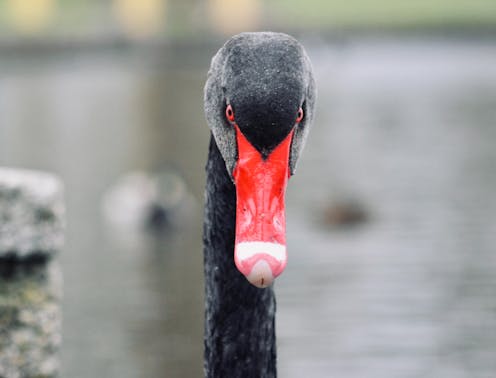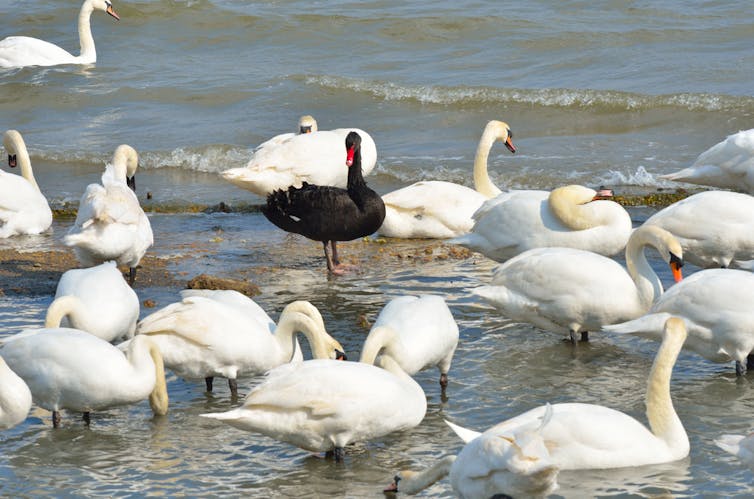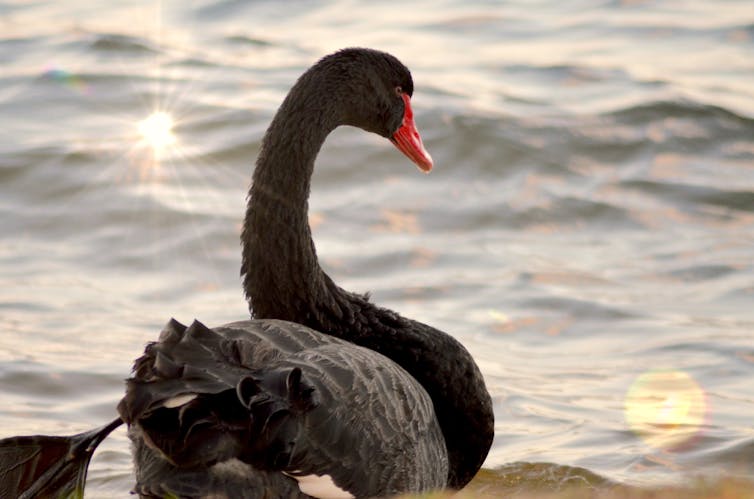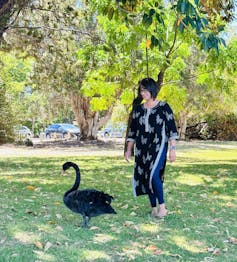Source: The Conversation (Au and NZ) – By Parwinder Kaur, Associate Professor | Director, DNA Zoo Australia, The University of Western Australia

For years, scientists have known bird flu kills every black swan it infects. This means if the disease made it to the Australian continent, it would be an existential threat to this iconic Aussie species.
A new study published today in Genome Biology finally reveals the gene contributions that make black swans particularly prone to falling victim to infectious diseases.
The relative geographic isolation of the black swan (Cygnus atratus) may have resulted in a limited immune toolbox, making them more susceptible to the infectious avian diseases Australia has been largely shielded from.

Paul Wishart/Shutterstock
A DNA puzzle
Unlike mallard ducks (Anas platyrhynchos) and the white-coloured mute swan (Cygnus olor), the black swan is extremely sensitive to highly pathogenic avian influenza or HPAI, commonly known as “bird flu”.
In May 2021 a collaborative effort between University of Western Australia and University of Queensland mapped the DNA puzzle of the black swan, which was released open-source through DNA Zoo.
To understand whether the geographically-isolated black swan has a different immune gene repertoire compared to its relatives, for the past two years we have worked on comparing the black swan genome to that of the closely related – yet genetically distinct – Northern Hemisphere mute swans. This work was done by a large team of scientists from Australia, New Zealand, Sweden, Germany, Japan, USA and UK.
Harnessing the power of high-performance computing, we mapped and compared tens of thousands of genes between the two species, to better understand why black swans fall victim to the virus so easily while mute swans do not. Such work is akin to finding a needle in a haystack.
Our work has now provided insights into how these species diverge genetically in response to the deadly bird flu and other viruses in the same family.

Parwinder Kaur, Author provided
Some missing genes
Notably, we found the black swan showed undetectable gene expression in toll-like receptor (TLR-7), a class of proteins responsible for the immune system’s reaction to foreign viruses. In other words, they have the gene for it, but it’s not turning on for some reason.

Parwinder Kaur, Author provided
The TLR-7 family has been extensively studied in humans, as it is known to play a role in virus and tumour cell recognition. A 2021 study showed TLR-7 is crucial to the pattern recognition receptors (the molecules that can detect pathogens) of SARS-CoV-2 in humans.
In infected endothelial cells – the cells lining blood vessels and the heart – of the black swan, we found a dysregulated (abnormal) pro-inflammatory response. When the immune system reacts to a threat, some inflammatory response is normal, but it’s possible it can cause a more severe reaction if dysregulated.
Read more:
Black swans and other deviations: like evolution, all scientific theories are a work in progress
Risking a wipe-out
Our work has also found the black swan genome was contractive. This means that from their last common ancestor with mute swans, black swans lost more genes in total than they gained.
Specifically, 39 immune-related gene families of the black swan were contractive as compared to the mute swan. This could be because being relatively isolated in Australia, they were less exposed to infectious bird diseases.
The data gathered by this sequencing project indicate the immune system of the black swan is more susceptible to any avian viral infection if it were to arrive in its native habitat. In other words, bird flu could even risk wiping out this species.
Now that we understand the potential underlying mechanism for black swans’ susceptibility to bird flu – and given TLR-7 is such an extensively studied gene in humans – there are several ways we can save our precious swans.
One way would be to look for natural variation that exists for this particular gene family in different black swan populations across Australia, Tasmania and New Zealand. There are likely to be individuals with higher resistance to bird flu, and we could use them to develop a strategic breeding program for this species.
Otherwise – and a more expensive path – would be to develop immunotherapy treatments, such as we have developed for humans. The good news is we now know what could be done to protect these swans.
Read more:
Friday essay: a rare bird — how Europeans got the black swan so wrong
![]()
Parwinder Kaur does not work for, consult, own shares in or receive funding from any company or organisation that would benefit from this article, and has disclosed no relevant affiliations beyond their academic appointment.
– ref. Australia’s iconic black swans have a worrying immune system deficiency, new genome study finds – https://theconversation.com/australias-iconic-black-swans-have-a-worrying-immune-system-deficiency-new-genome-study-finds-198159







